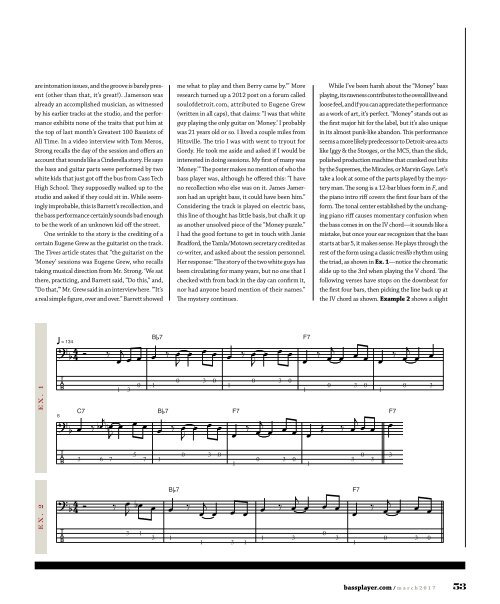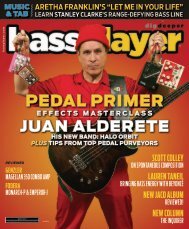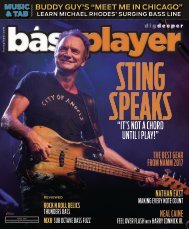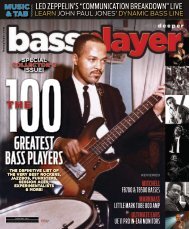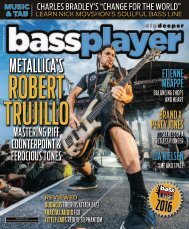BassPlayer 2017-03
BassPlayer 2017-03
BassPlayer 2017-03
Create successful ePaper yourself
Turn your PDF publications into a flip-book with our unique Google optimized e-Paper software.
are intonation issues, and the groove is barely present<br />
(other than that, it’s great!). Jamerson was<br />
already an accomplished musician, as witnessed<br />
by his earlier tracks at the studio, and the performance<br />
exhibits none of the traits that put him at<br />
the top of last month’s Greatest 100 Bassists of<br />
All Time. In a video interview with Tom Meros,<br />
Strong recalls the day of the session and offers an<br />
account that sounds like a Cinderella story. He says<br />
the bass and guitar parts were performed by two<br />
white kids that just got off the bus from Cass Tech<br />
High School. They supposedly walked up to the<br />
studio and asked if they could sit in. While seemingly<br />
improbable, this is Barrett’s recollection, and<br />
the bass performance certainly sounds bad enough<br />
to be the work of an unknown kid off the street.<br />
One wrinkle to the story is the crediting of a<br />
certain Eugene Grew as the guitarist on the track.<br />
The Times article states that “the guitarist on the<br />
‘Money’ sessions was Eugene Grew, who recalls<br />
taking musical direction from Mr. Strong. ‘We sat<br />
there, practicing, and Barrett said, “Do this,” and,<br />
“Do that,”’ Mr. Grew said in an interview here. ‘“It’s<br />
a real simple figure, over and over.” Barrett showed<br />
me what to play and then Berry came by.’” More<br />
research turned up a 2012 post on a forum called<br />
soulofdetroit.com, attributed to Eugene Grew<br />
(written in all caps), that claims: “I was that white<br />
guy playing the only guitar on ‘Money.’ I probably<br />
was 21 years old or so. I lived a couple miles from<br />
Hitsville. The trio I was with went to tryout for<br />
Gordy. He took me aside and asked if I would be<br />
interested in doing sessions. My first of many was<br />
‘Money.’” The poster makes no mention of who the<br />
bass player was, although he offered this: “I have<br />
no recollection who else was on it. James Jamerson<br />
had an upright bass, it could have been him.”<br />
Considering the track is played on electric bass,<br />
this line of thought has little basis, but chalk it up<br />
as another unsolved piece of the “Money puzzle.”<br />
I had the good fortune to get in touch with Janie<br />
Bradford, the Tamla/Motown secretary credited as<br />
co-writer, and asked about the session personnel.<br />
Her response: “The story of the two white guys has<br />
been circulating for many years, but no one that I<br />
checked with from back in the day can confirm it,<br />
nor had anyone heard mention of their names.”<br />
The mystery continues.<br />
While I’ve been harsh about the “Money” bass<br />
playing, its rawness contributes to the overall live and<br />
loose feel, and if you can appreciate the performance<br />
as a work of art, it’s perfect. “Money” stands out as<br />
the first major hit for the label, but it’s also unique<br />
in its almost punk-like abandon. This performance<br />
seems a more likely predecessor to Detroit-area acts<br />
like Iggy & the Stooges, or the MC5, than the slick,<br />
polished production machine that cranked out hits<br />
by the Supremes, the Miracles, or Marvin Gaye. Let’s<br />
take a look at some of the parts played by the mystery<br />
man. The song is a 12-bar blues form in F, and<br />
the piano intro riff covers the first four bars of the<br />
form. The tonal center established by the unchanging<br />
piano riff causes momentary confusion when<br />
the bass comes in on the IV chord—it sounds like a<br />
mistake, but once your ear recognizes that the bass<br />
starts at bar 5, it makes sense. He plays through the<br />
rest of the form using a classic tresillo rhythm using<br />
the triad, as shown in Ex. 1—notice the chromatic<br />
slide up to the 3rd when playing the V chord. The<br />
following verses have stops on the downbeat for<br />
the first four bars, then picking the line back up at<br />
the IV chord as shown. Example 2 shows a slight<br />
= 134<br />
Bb7<br />
F7<br />
Ex. 1<br />
6<br />
0 3 0<br />
0 3 0<br />
0 1<br />
1<br />
0 3 0<br />
1 3<br />
1<br />
1<br />
C7 Bb7 F7 F7<br />
0 3<br />
3 6 7<br />
5<br />
7 1<br />
0 3 0<br />
1<br />
0 3 0<br />
1<br />
3<br />
0<br />
3<br />
3<br />
Bb7<br />
F7<br />
Ex. 2<br />
3 1<br />
3 1<br />
1 3 1<br />
1 3<br />
0<br />
3<br />
1<br />
0 3 0<br />
bassplayer.com / march<strong>2017</strong> 53


